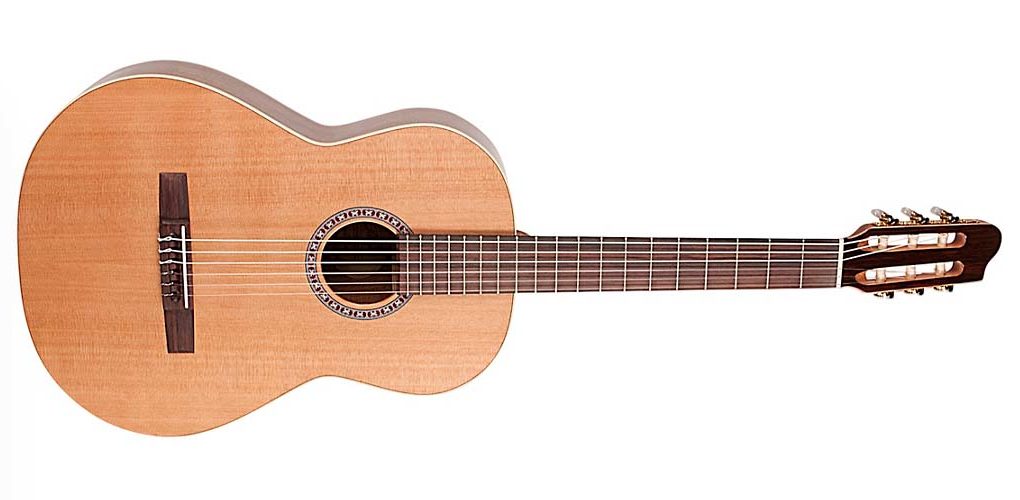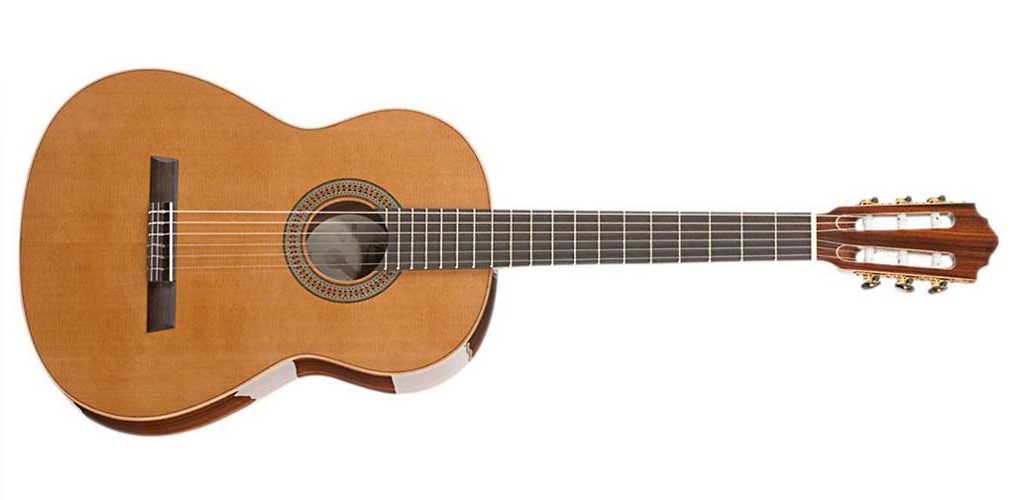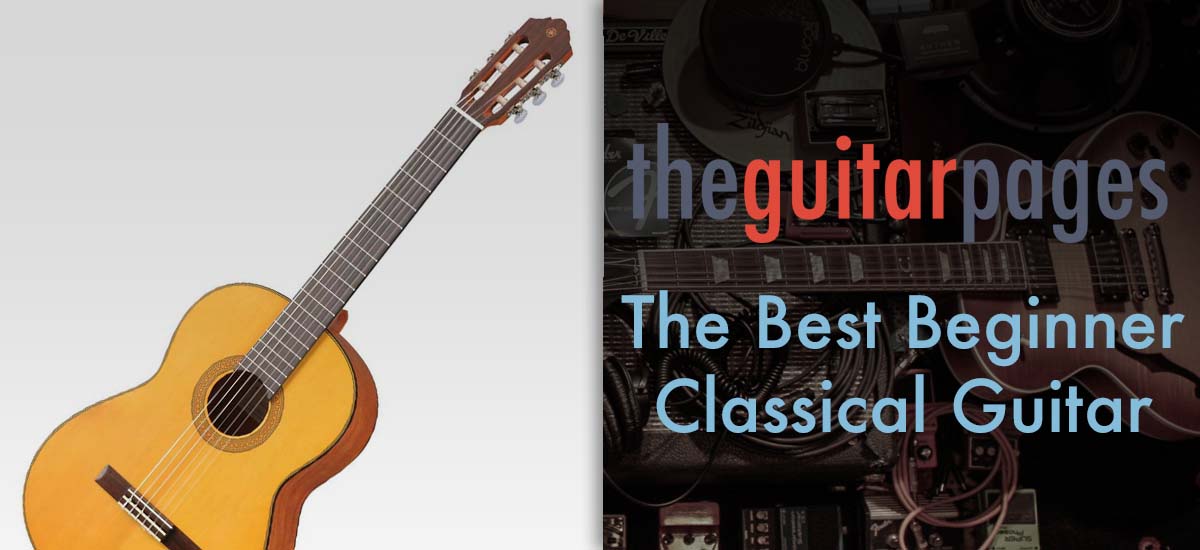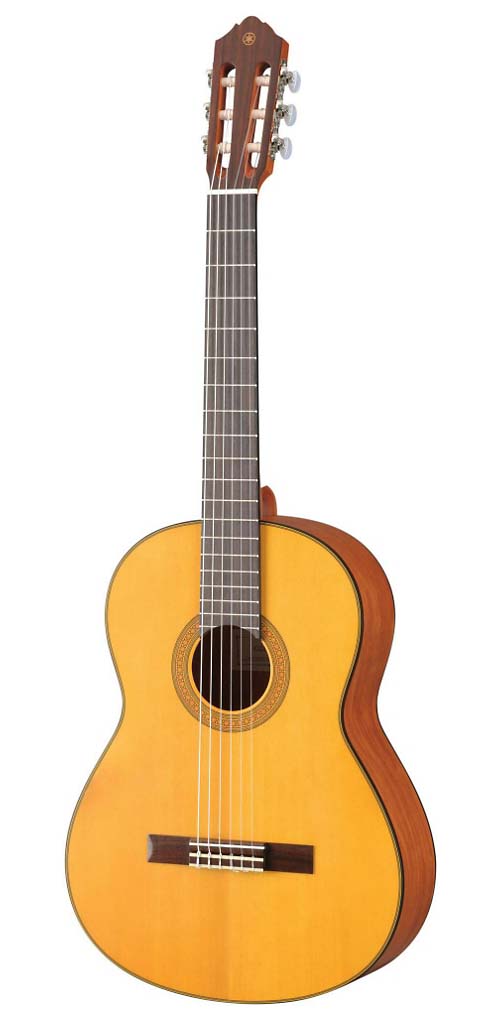Many beginner guitar programs and classes require starting on a classical guitar, but why is this? While the nylon strings of a classical guitar tend to be easier to press down than acoustic steel strings, this is not the main reason. Classical guitar lends itself perfectly to learning how to read and play along to music notation, gaining dexterity in the fretting hand, and situational string awareness with the hand plucking the strings.
If your child is starting in a class or program that is requiring a classical guitar, here are the best beginner classical guitars on the market.
Quick Summary
My recommendation for the best beginner classical guitar is the Yamaha CG122MCH Solid Cedar Top Classical Guitar. It’s right around $200, is a great guitar to learn on, and will last many years.
It has a solid cedar top for a nice open sound, plied back and sides for strength (important if a kid is using it), and it is built incredibly well. I’m a big fan of Yamaha instruments. This is a guitar that your kid will be able to grow into, both physically size wise, and as an instrument. You could get at least 3-6 years out of this guitar before needing to move up in quality.
Get it in the standard classical style without the acoustic-electric option, and get a case for it too. My favorite add-on case is the TRIC which is thermal regulated, made of super durable polypropylene construction, as light as a gig bag, and as kid proof as possible. Check out more about these cases in The Ultimate Guitar Case Summary.
Price Range
For a beginner classical guitar, I don’t recommend going below $200. The guitars that are closer to $100 I find to not have great build quality, and they tend to sound pretty bad.
You want your child (or you) to enjoy playing, and one of the factors of that is the sound quality. If a guitar you’re trying to learn on sounds like a tin can with strings on it, you’re probably not going to want to pick it up too often. On the other hand, a guitar that produces are nice, warm tone is going to highlight your progress and make you want to play more.
In this post, I’m going to include a classical guitar that I would recommend for a beginner classical player in three different price ranges. One right around $200, one right above $500, and the last just above $700.
While most people tend to think of a beginner instrument as having lesser quality to compliment an introductory price, all of these recommendations are built to last and they sound great.
l included the higher priced classicals in this article because many people like to purchase an intermediate guitar when they’re starting to insure both great quality from the start and and instrument they won’t grow out of too quickly.
Going with the second two options below certainly ensures more time before you’ll want to upgrade. When it is time, you’ll have a great instrument that can be used as a backup, taking the old one when you want to keep your premium guitar safe at home.
In general, when looking at classical guitars, up to $300 is the beginner range, $300 – $1500 is the intermediate range, and $1500 and up is the advanced range.
Scale Length
Overall guitar sizes are described in terms of scale length. This is either in inches (a Fender Stratocaster has a scale length of 25.5”) or in fractions for guitars smaller than full size. For example, you can have a full scale, ¾, ½ and so on scale classical guitar.
If you’re trying to buy a guitar for a child, it can be difficult to know what size of guitar to buy. A good rule of thumb is to have them sit with a guitar in the playing position, and have them reach out and grab the headstock on the guitar neck (where the string tuners are). If they can reach the tuners without straining, then they’ll be able to reach all of the notes on that guitar.
But, guitars are a bit like shoes in that sense, and if your child is growing rapidly, know that they’ll probably grow into a guitar quite quickly. In that case you’ll want them to have a full scale guitar and not something too small for them. Kids get bigger, guitars don’t.
You might be tempted to buy a ¾ scale guitar because you have a kid, and the full scale guitar looks pretty big. In my experience if your kid is at least 11 years old, going with a full scale guitar is almost always the right choice.
Scale Length and Intonation
The intonation on a guitar describes how well a string stays in tune as you play it up the fretboard. It may be in tune when you pluck the string open, but by the time you’re playing up around the 7th fret your notes might be a little sharp. That string wouldn’t be intonating correctly and you may or may not be able to fix that.
Because a smaller scale guitar is just a shrunken down version of a full scale guitar, the frets are relatively in the same place, but their actual distances are also shrunken down. This act of squishing the frets into a smaller space means frets have to be perfectly precise in order to maintain proper intonation. I find that until you get into much higher price points, all small scale guitars tend to suffer from this intonation problem.
The principle question, “How often do you need to change acoustic guitar strings?”, holds true for classical guitars as well. The biggest indication that a string has seen its full life is a lack of intonation. If the string is in tune when played open, but not when played up the neck, there’s a good chance your string is bad. Replace them all to fix the problem.
String Type
You’ll quickly find out that there are a couple different types of classical guitar strings, and you’ll be left wondering which set is right for a beginner.
It’s incredibly important to never put steel strings on a classical guitar. The bracing and bridge of a classical guitar is not built for the higher tension of steel strings and will almost always cause major damage to the guitar. Again, when putting strings on a classical, make sure the strings are classical strings and not steel strings.
Tension
What is the best classical guitar string tension for a beginner? Normal and high tension classical string sets are the most common, but as a beginner you’ll want to get normal tension strings. High tension strings sound great as they project a bit louder, but they also require greater finger strength, which is something beginner players generally don’t have an excess of. Get normal tension.
D’Addario Pro-Arte Normal Tension Classical Strings, Amazon
End Type
The next consideration, is the type of end on the string. These can be traditional (with no end), or a ball end. Tying classical strings correctly can be quite tricky at first, so I suggest going with the ball end strings. Sure, they’re not fancy schmancy, but the get the job done just fine.
An incorrectly looped classical string can actually come undone when the string is brought up to tension, often causing the string to whip around into the top of the guitar and cause damage either to the guitar or the person closest to it. The safe option here is going with ball ends that won’t ever do that.
Martin Classical W/ Ball End, Amazon
Cedar Top Vs. Spruce Top
Another common option that you’ll encounter with classical guitars is the type of top wood. Traditionally, you’ll see both cedar and spruce. So which one should you get?
For a beginner, it really doesn’t matter. What matters is that you’re getting a classical guitar with a solid top. The guitars that I recommend here all have solid tops, but that isn’t a given for beginner models. When doing your research make sure the description specifically calls it a “solid” top.
A cedar top will have a warm tone, strong mid-range presence, and sound really lovely when it has opened up a bit. Cedar is often described as being darker in sound than spruce is.
A spruce top, while being more traditional, has a clear bright tone that accentuates the bass and treble notes and makes for a nice pairing with classical music.
At the end of the day, both tonewoods make for a great sounding classical guitar and either would sound great for a beginner. If you still can’t decide, go with spruce. It is definitely more traditional and the sounds coming out of your guitar will most likely match the classical music you’ve been dutifully spinning.
Should I Get An Acoustic-Electric Classical Guitar?
Many classical guitar models also offer a version that contains electronics. This gives you three things: a pickup so you can plug into an amplifier, a tuner that is built into the pre-amp, and a massive headache when it stops working, or you have to keep buying batteries for it.
My suggestion is to not buy the electronic model unless you specifically need to plug into an amplifier. Even then, there are options for soundhole pickups that work great, are inexpensive, and just slip in and out.
My biggest problem with electronics is that it’s generally a considerable price hike without much payoff. For example, my base beginner classical guitar suggestion the Yamaha CG122 (at the time of writing this post) is $220. The model with a pickup in it, the Yamaha CGX122MSC, comes in at $430. That’s $210 more dollars for a pickup that probably won’t get used that often! Save yourself some money and get the version without electronics.
Acoustic guitars with electronics in them are almost always cutaways, meaning that the body of the guitar on the treble side is cutaway to allow easier access to those notes. This isn’t necessary at all on classical guitars, and should not be seen as a feature. This is another reason to not get a classical guitar with electronics in it.
All that the cutaway does is decrease the amount of volume inside the body of the guitar. This means that the overall sound of the guitar diminishes and you’ll get less overall volume, and quality of tone out of the guitar.
There’s one more beef I have with onboard electronics, and that is the tuner. While having a tuner built into the guitar may sound handy, it’s more often a nuisance that eats batteries and often doesn’t work that great.
Don’t bother with junky onboard tuners, really good clip on tuners are cheap, their batteries are inexpensive, and if they break it’s only a couple bucks, not a costly repair involving your entire guitar.
Did I convince you? I hope so. If you’re a beginner, don’t get a classical guitar with electronics. You don’t need it, it’ll be more expensive, and it won’t sound as good as just the standard version.
Top 3 Beginner Classical Guitars
Good: The Yamaha CG122
First up for the best beginner classical guitar is the Yamaha CG122. This guitar features a solid top and plied back and sides. The solid top either comes in Spruce or Cedar, both giving great tones and sweet sounds. (If you’re trying to decide between Spruce or Cedar, read the section above).
Yamaha CG122 Solid Spruce Top, Check Price on Amazon
This is the perfect classical guitar to learn on, and will provide a quality and sturdy platform to learn classical music for quite a few years. If you’re buying a guitar for a kid who’s learning, this is the perfect option. The plied back and sides offer a durability that helps a lot when, and let’s be honest, being careful is not the top priority of most kids.
I really like the satin feel of the top, body, and neck, and another plus of a satin finish is that it’s less likely to get and look dirty. Gloss finishes are nice, but they have to be wiped down constantly or else they get all smudged and can start looking gross. Has your kid ever had sticky fingers? Yeah, let’s keep those away from a nice glossy topped guitar.
I love this guitar, and highly recommend it to anyone looking for an affordable entry level instrument that plays and sounds great. Can’t go wrong here.
Better: Godin Concert Nylon-String Guitar Natural

Next up is the Godin (pronounced go-dan) Concert Classical. Anything that this company makes is worth playing. These are Canadian made instruments that are very high quality in both material and craftsmanship.
The top is a solid cedar tonewood, and the back and sides are solid mahogany. Mahogany is another tonewood that produces a strong, warm tone. These two together make a great combination and a lovely sounding instrument.
Godin pressure test each and every guitar top, which means an extremely high level of quality assurance. This provides consistency across all guitar tops which guarantees it will sound as great as the one being made right next to it. This is very comforting when buying a guitar on the internet.
I love the Godin Concert classical guitar. This would make an amazing guitar for a beginner that will last well into the high intermediate and low advanced levels. I’ve also known many advanced players that buy these as a second guitar to their super fancy classicals that never leave the house.
Truly an awesome choice.
Best: Hofner Solid Cedar Top Rosewood Body Classical Acoustic Guitar

And to round out our list of best beginner classical guitars is the Hofner Classical featuring a solid cedar top and solid rosewood back and sides. This is an interesting combination of tonewoods, as rosewood provides a nice mid scoop in the frequency response while the cedar top accentuates those frequencies. They complement each other very nicely.
The Hofner features beech binding, which looks great tying the side and top woods together. It also boasts a beautiful glossy finish that shows off the quality of this instrument. This guitar is made in Germany, and would be a very nice guitar to learn on. Because of the price range, this guitar is for the player who knows that they’ll be sticking with it, and who wants something that will last for many years.
Hofner is a German instrument maker that has been making instruments in Germany since 1887. So yeah, they’ve got a thing or two figured out about how to make great guitars. I don’t even have to say it, but if you decided to get a classical guitar of this caliber right out of the gate, you would not regret it.
Accessories for Playing Classical Guitar
Alright, you picked out a guitar, isn’t that all there is? Unfortunately no, there are a couple more accessories you’re going to want to have right out of the gate.
Classical Guitar Case
None of the guitars I’ve mentioned come with cases. This isn’t uncommon for guitars under $1500, and when they do have cases they’re usually pretty flimsy.
My favorite acoustic case of all time is the TRIC cases made by our friends Godin. You’ll see them branded for their different guitar lines, but they’re all the same and incredible. I’ve mentioned them before, but I love these cases for a couple reasons.
First, they’re super light which makes carrying it around a breeze, especially for a kid.
Second, they’re made of polypropylene (same as the material behind modern car bumpers) which is super sturdy, impact resistant, and resistant to tears or damage that hardshell cases would crumble under.
And finally, they do a great job of holding in humidity and regulating temperature. This is necessary if you’re like me and live in a part of the country that goes from extreme heat in the summer to extreme cold in the winter with humidity levels all over the place.
Foot Stand
Unlike a steel string acoustic, classical guitars are played by raising the left foot (if right handed) and setting the guitar on the left thigh.
For this, a footstool achieves the proper height and angle, allowing for proper posture and the ability to reach all of the notes on the guitar neck properly. This is incredibly important for new players who are just learning the basics. Starting with a solid foundation will lead to successfully learning how to play.
On Stage Classical Guitar Foot Stool, Amazon
Clip-on Tuner
As mentioned before, you don’t need to get a classical that has built in electronics. Although most of those include a tuner that is built in, they rarely work as well as clip-on tuners do, and they can eat through 9v batteries like crazy. Especially if you forget to turn the tuner off. Which, trust me on this, happens all the time.
D’addario Eclipse Clip-on Tuner, Amazon
This is my favorite clip on tuner that is cheap and works great with all instruments, classical guitar included.
Classical Guitars and Humidity
All of the classical guitars that I’ve recommended have at least solid tops on them. This means that you need to be using a humidifier with your guitar to ensure the wood is getting enough moisture.
Read my article about guitars and humidity to learn more about keeping your guitar happy with the right levels of humidity.
Make sure to pick up a humidifier like the oft-used, and cheap D’Addario Planet Waves Acoustic Guitar Humidifier. Fill the sponge with fresh water once every 1-2 weeks and you’ll be in good shape. Just make sure to squeeze the excess water out of the sponge before putting it back in the guitar. I have a story about that. It didn’t turn out great.
Conclusion
If you’re looking for a beginner classical guitar, look at these three which are all great instruments. Don’t spend more than you can afford, but also don’t skimp when it comes to choosing an instrument. I know that I’m much more inclined to pick up my guitar when it sounds and feels great.






